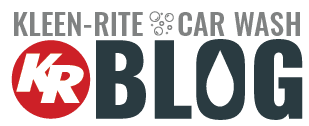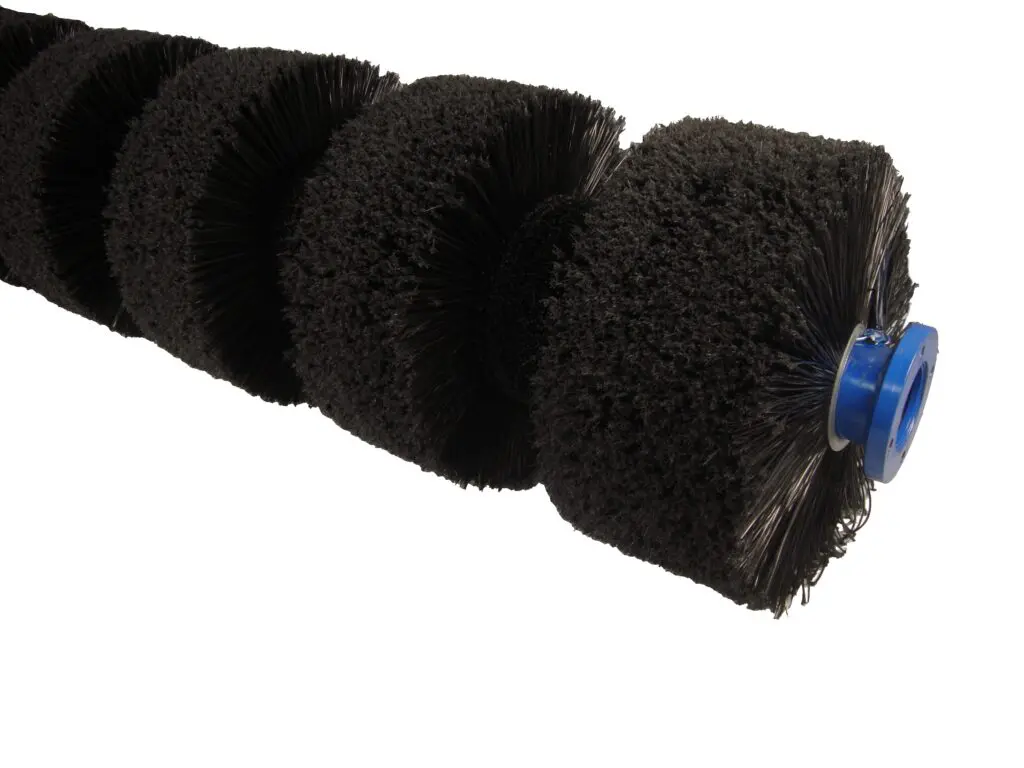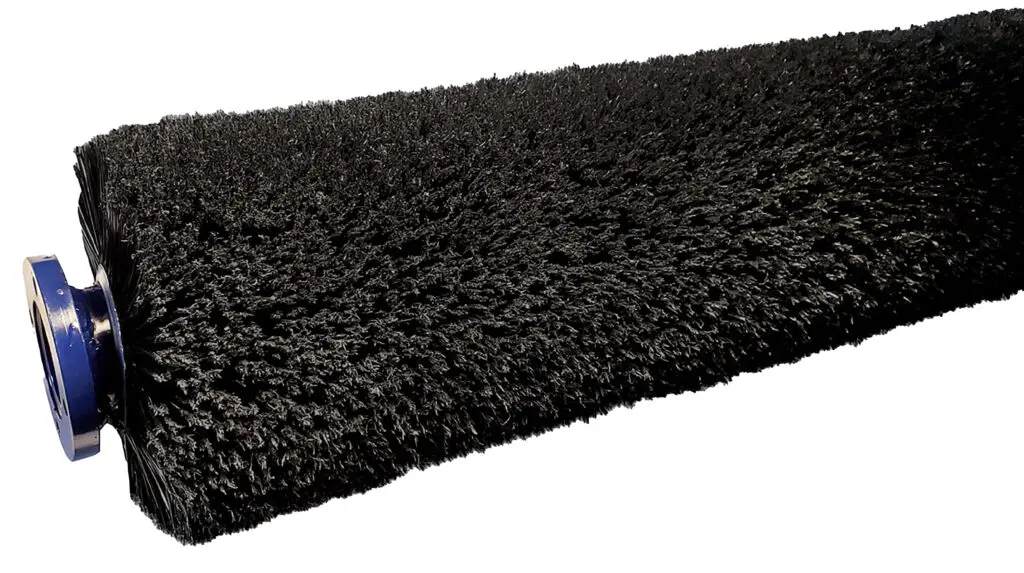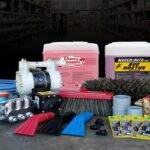In a busy car wash tunnel, every piece of equipment plays an important role, and tire brushes are no exception. These brushes take on one of the toughest jobs, scrubbing away built-up dirt and grime to prep each tire for a spotless shine.
Large-format tire brushes are essential to any successful car wash tunnel. They are used to remove stubborn road film, debris, and brake dust that accumulates on them from daily driving, preparing them for tire shine. By thoroughly prepping each tire, these brushes ensure the tires are ready to accept the tire shine. When tires are properly prepared, your tire dressing applicator brushes can apply product more evenly. This helps the dressing adhere better and last longer, ensuring a professional finish for your customers. High-quality tire brushes don’t just improve a vehicle’s appearance; they also help your tunnel run more efficiently.
These brushes are a significant investment, and we know you’ll want to get the most out of them. With proper care and a few simple maintenance habits, you can extend their lifespan and keep your tunnel operating smoothly for the long haul.
In this article, you’ll discover how to recognize signs of tire brush wear, implement effective maintenance practices, and clean your brushes properly when necessary to ensure optimal performance.
Table of Contents
- Tire Cleaning Brushes vs. Tire Dressing Applicator Brushes: Key Differences and Uses
- Poodle Style Brushes
- Tire Scrub Brushes
- Tire Dressing Applicator Brushes
- What You Need to Know About Tire Brush Wear
- How Frequently Should You Inspect for Wear
- Factors that Impact Brush Wear
- Maintenance Recommendations from John Mundo
- Flip the Brushes End-To-End
- Switch the Brushes to the Opposite Side of the Conveyor
- Easy Steps to Flip and Rotate Tire Brushes
- Tips for Handling the Brushes
- Recommended Time Intervals to Rotate and Flip Your Tire Brushes
- Should You Clean Your Tire Brushes?
- How Long do Car Wash Tunnel Tire Brushes Last?
- Factors that Influence Brush Replacement Frequency
Tire Cleaning Brushes vs. Tire Dressing Applicator Brushes: Key Differences and Uses
Tire cleaning brushes and tire dressing applicator brushes each serve a unique purpose in a car wash tunnel, and understanding their differences helps ensure the best results for your customers.
Understanding Tire Cleaning Brushes
There are two types of brushes used to clean tires in car wash tunnels and express washes.
Poodle Style Brushes Explained
The first and now the gold standard is the Poodle Style, otherwise known as Hubcap, Wheel, Rim Brushes. These brushes are designed with alternating sections of long and short bristles to provide thorough cleaning for both tires and wheels. The longer bristles reach between the spokes and into tight areas on wheels with complex designs. The shorter bristles focus on scrubbing tires and wheel surfaces, effectively removing road grime and brake dust.
Tire Scrub Brushes Explained
When car wash tunnels first became popular, tire scrub brushes were used to remove road grime and brake dust from whitewall tires that have since gone out of style. Today, these brushes are much less common, as most car washes have transitioned to the more effective Poodle Style brush for superior tire and wheel cleaning performance.
Understanding Tire Dressing Applicator Brushes
Tire dressing applicator brushes are used to apply tire shine evenly onto the surface of clean tires. These applicator brushes feature feathered, soft, and flexible bristles that hold tire shine solution, allowing for even distribution and a consistent, professional finish on every tire. They are used during the final stage in the car wash to add a touch of shine that showcases your commitment to quality and attention to detail.
What You Need to Know About Tire Brush Wear
Let’s take a closer look at how tire brushes in car wash tunnels and express washes naturally experience wear over time. When inspecting your tire brushes for signs of wear, you’ll keep these key factors in mind to maintain optimal cleaning performance and protect your investment.
The Driver’s Side Brush Wears Out Sooner
The driver’s side brush typically wears out faster than the passenger side because the conveyor system applies greater pressure in that area of the vehicle. As cars move through the wash, the conveyor often aligns and pushes against the driver’s side to guide vehicles accurately. This extra contact results in increased wear on the equipment along that side. In comparison, the passenger-side brush experiences less pressure and friction, allowing it to maintain a longer service life.
The Entrance End of the Brush Wears Out Faster
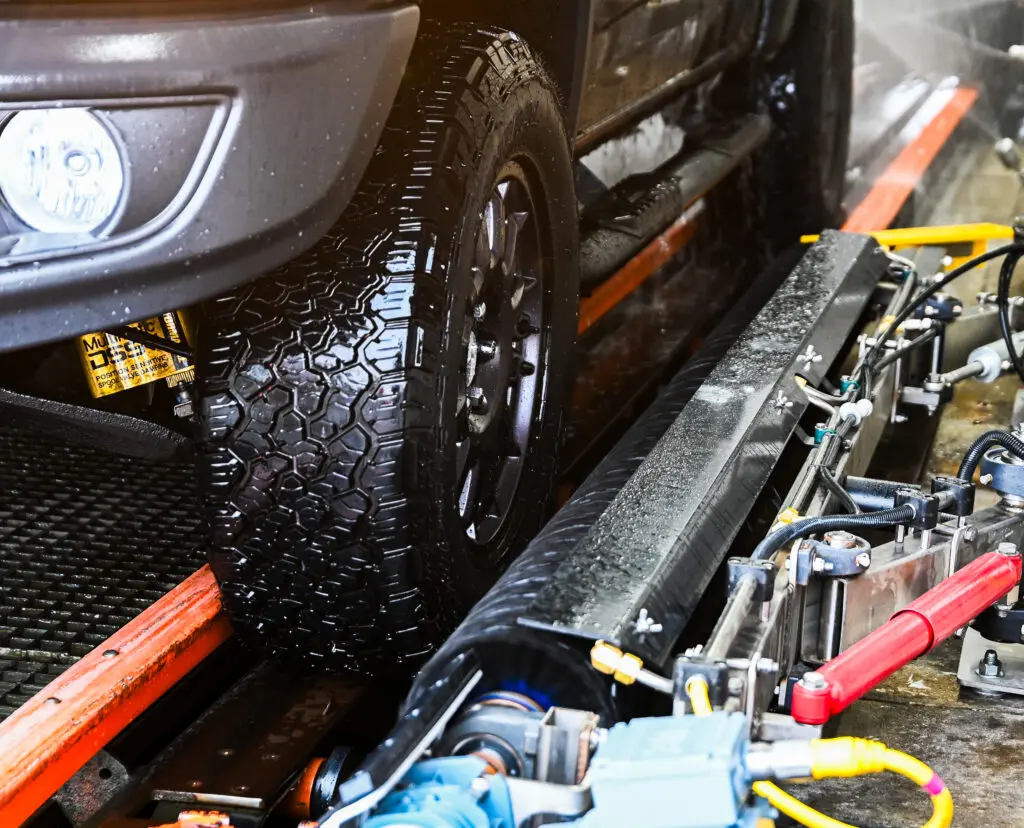
Another crucial area to watch is the section of the brush that makes initial contact with each vehicle. As cars repeatedly pass through, increased force and friction on these bristles cause them to lose their shape and cleaning effectiveness more quickly than those in the middle or rear of the brush.
Recognizing Wear in Different Brush Materials
Each type of brush material exhibits unique signs of wear as it ages. Recognizing these indicators can help you determine when it’s time to replace your brush and maintain optimal performance.
Poly Bristles – experience tip wear, slowly shortening over time, much like a pencil that’s repeatedly sharpened. This gradual wear can impact the brush’s overall efficiency if left unchecked.
Nylon bristles – will begin to lay down and lose their stiffness as they wear out. Over time, this reduces their ability to reach into tight areas and clean surfaces thoroughly.
How Frequently Should You Inspect for Wear
A common question is, “How often should I inspect the bristles on the tire brushes in my tunnel?” Generally, it is recommended to check your tire brushes for bristle wear once a month. However, you might want to inspect them more frequently, since various factors can affect how quickly a brush wears out.
Factors that Impact Brush Wear
Monthly Vehicle Throughput in Your Tunnel – Higher traffic through your tunnel results in faster tire brush wear, as increased use and friction take their toll. If your wash serves large fleets or accommodates a high number of vehicles daily, be sure to inspect and maintain brushes more frequently. In lower-volume tunnels, brushes experience less wear and therefore require less frequent attention. By regularly monitoring vehicle counts, you can establish an optimal maintenance schedule that maintains cleaning quality and maximizes the lifespan of your brushes.
The Amount of Pressure Applied to the Brush – Pressure is a key factor in how quickly your tire brush’s bristles wear out. Applying too much pressure increases friction, causing the bristles to bend beyond their limits, resulting in faster wear and a shorter brush lifespan. Conversely, too little pressure can lead to poor cleaning results, as the brush may not make consistent contact with the tire surface. Finding the right balance ensures effective cleaning while extending the life of your equipment.
Regularly check and adjust the pressure to ensure it’s just right for the mix of vehicles brought to your wash. Most modern equipment installed in car wash tunnels allows you to fine-tune the pressure settings, so take advantage of these controls to optimize both efficiency and equipment longevity. By maintaining the right amount of pressure, you help extend the life of your brushes and deliver consistent cleaning results for every customer.
Brush Rotation Speed – The rotation speed of the brush is another critical factor that impacts the rate of bristle wear on tire brushes. If the brushes rotate too fast, the increased speed creates more friction and heat between the bristles and the tires. This causes the bristles to break down and wear out faster. On the other hand, if the brushes spin too slowly, they won’t clean the tire surfaces as effectively. This is due to less contact and agitation.
Set the rotation speed to the manufacturer’s recommended setting and adjust based on the type and volume of vehicles customers take through your wash. Consistently monitoring and fine-tuning the rotation speed allows you to achieve optimal cleaning results while extending the life of your tire brushes.
Types and Sizes of Vehicles Washed – Larger vehicles, including trucks, SUVs, and wide-body sports cars, place more pressure on the brush bristles than smaller sedans, causing the bristles to wear out faster. Wider tires or those with aggressive treads, such as those used for off-road driving, can also make the brushes wear down more quickly. Washing a mix of different vehicle types can lead to uneven or faster bristle wear compared to washing mostly regular cars. Keep track of the size and types of vehicles brought to your wash so you can adjust your maintenance and replacement schedules. This will help your equipment last longer and continue providing the quality your customers expect.
Maintenance Recommendations from John Mundo at Universal Brush
Now that you understand where brushes most commonly wear out and how to identify signs of bristle deterioration, let’s review Universal Brush’s maintenance recommendations.
John Mundo, President of Universal Brush, shared insightful maintenance tips during a recent training presentation he gave to our employees at Kleen-Rite.
Flip the Brushes End-To-End
Flip the brushes end-to-end to help even out wear. By reversing the orientation, the less-used side becomes the leading edge, which can extend the overall life of the brush and maintain more consistent cleaning performance across the entire surface.
Switch the Brushes to the Opposite Side of the Conveyor
Move each brush to the opposite side of the wash to distribute wear more evenly. This preventative measure helps maintain optimal performance, reduces uneven bristle wear, and can save on replacement costs over time.
Easy Steps to Flip and Rotate Tire Brushes:
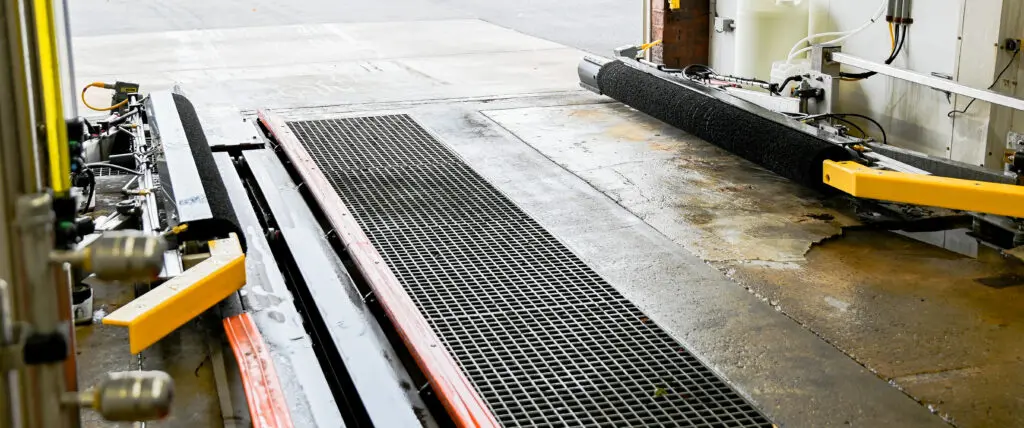
Flipping and switching your brushes is easier than it sounds. Here’s a simple step-by-step guide to help you flip them end-to-end and swap their sides for even wear.
- Unbolt the flanges on both ends of the brush to release it from the mounting system.
- Carefully remove the brush once the flanges are disconnected.
- To keep wear balanced, flip the brush end-to-end, move it to the other side of the wash, or tackle both at once.
- Securely reattach the flanges by bolting them back into place.
- Once everything is tightened, your brush is back in the system and ready to go.
Note: This maintenance tip will maximize bristle lifespan when both tire brushes are installed simultaneously.
Tips for Handling the Brushes:
- Handle with Care: Avoid dropping the brush. Even a single fall can upset its balance and make it less effective at cleaning.
- Keep the Brush Off the Ground: Don’t let the brush touch the ground. This keeps it clean and avoids bending or damaging the bristles.
- Ask for Help Lifting the Brushes: These brushes are long and heavy, so having a few people help handle them will make the job safer and much easier. It also lowers your chances of dropping the brush.
Recommended Time Intervals to Rotate and Flip Your Tire Brushes
Mundo recommends performing this maintenance every 6 to 12 months. The exact frequency depends on the number of cars your wash processes each month. Higher-volume washes may need to do this closer to the 6-month mark. While lower-traffic locations may be able to stretch closer to a year. Staying on top of this schedule helps to extend the life of your brushes and maintain consistent cleaning performance. It will also reduce unexpected downtime and ensure you’re getting the maximum value from your investment.
Should You Clean Your Tire Brushes?
You might be asking yourself whether it’s necessary to clean the tire brushes in your car wash tunnel. In most cases, you don’t need to clean them. However, there are instances in which occasional cleaning may be required. The most common reason these brushes may need to be cleaned is due to foreign debris, which is quite rare.
Cleaning Procedures for Poodle Style and Tire Scrubbing Brushes
Both poodle-style brushes and tire scrubbing brushes are usually self-cleaning. This is because soap or detergent is applied to them during the washing process. This not only helps clean the wheels but also acts as a lubricant to prevent them from scratching wheel finishes. As these brushes spin, the cleaning solution captures and lifts away dirt, which is then rinsed off. This efficient process means additional cleaning is rarely necessary unless foreign objects become tangled in the bristles. In this case, you can clean them.
Rinse the brush using a low-pressure spray. Since these brushes are already saturated with soap from the car wash, additional cleaner is unnecessary. The primary goal when spraying down the brush is to dislodge and remove any debris. This prevents it from scratching or damaging customers’ wheels.
Cleaning Steps:
- Close down the tunnel.
- Spray down the brush as it rotates. Use low pressure.
- Confirm that all debris has been completely removed.
Cleaning Procedures for Tire Dressing Applicator Brushes
Generally, tire dressing applicator brushes in your tunnel do not require cleaning. This is because tire shine is applied after the vehicle has been thoroughly washed. Debris that might become trapped in the bristles should have been removed during the earlier stages of the wash.
If a foreign object gets lodged in the brush, rinse it with a gentle stream of water to dislodge the debris. There’s no need to use any chemicals, as the goal is to clear the bristles rather than wash the brush itself. Another situation that calls for rinsing is when leftover tire shine starts to harden on the bristles. In this instance, thoroughly spraying the brush will help restore its flexibility and ensure it’s ready to absorb fresh product.
Caution: Avoid rinsing the brush with a pressure washer; the intense spray can damage the bristles.
Cleaning Steps:
- Close down the tunnel.
- Spray down the brush with water as it rotates. Use low pressure.
- Inspect the brush and confirm that all debris or hardened tire shine has been completely removed.
How Long do Car Wash Tunnel Tire Brushes Last?
With proper care and by following the maintenance tips mentioned earlier, the lifespan of car wash tunnel tire brushes can extend over several years. However, it is challenging to provide a precise or average longevity due to the distinct characteristics of each car wash operation.
A large number of factors influence bristle longevity and replacement frequency, including monthly vehicle throughput in your tunnel, the amount of pressure applied to the brush, and brush rotation speed. Additionally, the sizes and types of vehicles processed by your tunnel play a significant role in determining how quickly tire brushes wear.
Factors that Influence Brush Replacement Frequency
Knowing when to replace your car wash brushes is crucial to maintaining quality results and protecting your equipment investment. Several factors determine how often you’ll need to replace brushes to deliver optimal results to your customers.

Type of Brush Material
- Both poly and nylon/poly bristle materials are low-maintenance and consistently deliver dependable results. Regular inspection and cleaning help maximize brush life and performance. However, poly-only brushes will wear faster than the nylon/poly combination fill.
Volume of Vehicles Washed
- High-traffic car wash locations experience faster brush wear due to the increased volume of vehicles. If your site washes hundreds of cars daily, expect to replace brushes more frequently than operations with a lower volume. By tracking your daily vehicle count, you can anticipate when replacements will be needed and help avoid unexpected downtime. This keeps your wash running smoothly for your customers.
Type and Condition of Vehicles
- Serving larger vehicles or those caked with dirt, mud, or ice can shorten brush life. Excess debris can accelerate wear and introduce materials that damage brushes and equipment. Locations focused on passenger vehicles usually see less severe wear.
Maintenance and Cleaning Practices
- Routine maintenance extends brush service life. Regular inspections, debris removal, and scheduled cleanings help keep brushes in top condition between replacements. Neglected brushes perform poorly and risk abrasive damage to vehicles.
Environmental Conditions
- Harsh environments such as extreme heat, road salt, or freeze-thaw cycles can increase brush wear. Over time, this exposure causes materials to break down faster.
While many operators find that these brushes typically last for years rather than months. The actual lifespan varies depending on several factors. They include usage level, maintenance routines, and material quality. Please note this estimate is intended for general guidance. It should NOT be interpreted as a guarantee of product lifespan.
As a general guideline, replace your car wash tunnel tire brush when you notice reduced cleaning performance, significant bristle deformation, or uneven wear that cannot be corrected.
Well-maintained tire brushes don’t just clean better, they keep your tunnel efficient, your customers happy, and help your profits grow. Take a little time for regular upkeep, and you’ll get maximum life, consistent performance, and cleaner results every time!
If you are looking for a reliable replacement, browse our Universal Brush Tunnel Tire Brushes. Designed for consistent tire cleaning and long-lasting performance, they help keep your car wash operating smoothly. If you need assistance ordering a replacement tire brush, our experienced team will help you select the right one!
About the Author
Phil Donnelly, aka Fix-It Phil
Kleen-Rite Equipment Engineer, Production Manager, Car Wash Operator
Best known for his “Fix-It Phil” persona on Kleen-Rite’s YouTube channel and podcast Kleen-Rite Radio, Phil Donnelly has become a trusted source of technical expertise for car wash owners, operators, and technicians. Beyond his on-screen guidance, Phil was the driving force behind the Operator Pro Plus pump stand, leading its design, testing, and production to create a highly effective solution for self-serve car washes. He also serves as the lead engineer and production manager for KR Equipment, our reliable line of car wash equipment designed and produced in-house specifically for the self-serve segment of the industry.
Before joining Kleen-Rite, Phil spent over 14 years servicing industrial boilers at Delval Equipment. This experience provided a strong technical foundation, enabling him to quickly master the equipment used in car washes due to the similarity of the required skills and knowledge. Phil attended Thaddeus Stevens College of Technology and graduated from the HVAC-R program with an Associate Degree.
